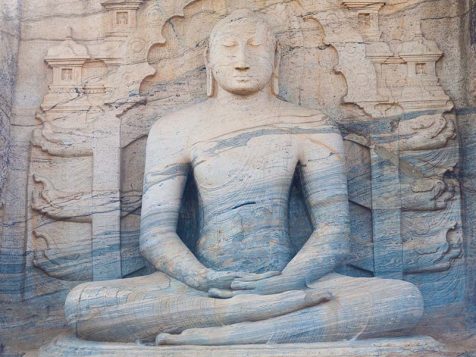An incredible work of art and one of the most esteemed and unique sites in the Polonnaruwa region is the Uttararamaya, also known as Gal Viharaya for the obvious reason that the entire area is composed of nothing more than pure rock. Constructed under the sponsorship of Parakramabahu I, it shows the impressive vision to turn the island into a developed, beautiful and prosperous place. It was built to commemorate his cleansing of the Brotherhood of Buddhist Monks upon ascending the throne.
After all, there were three sects of the clergy at the time. These three fraternities were the orthodox Mahavihara that preached Theravada Buddhism and the ever-growing Mahayana and Tantric schools of Abhayagiri and Jetavana. The king, with the assistance of the elders and chiefs of these sects, held a council and banished any corrupt monks from the fraternities and united them as one as per the edict of the Polonnaruwa Katikavata. In fact, in between the standing image and one of the smaller meditative images is a massive smooth rock, angled as it juts out of the rock face as a whole. The inscription is supposed to have been carved into this rock.
The statues at Gal Viharaya are immense, and a Lankan sculptural marvel, as they seem alive and three-dimensional, so powerful that one might forget that these are merely sculptures when the light and shadow fall across them.
Gal Viharaya was actually rediscovered in 1820 during the British era by Lt. Fagan, and he had to clear away the jungle grown over the mighty stone ruins of the older northern kingdoms. This was one of the places that he managed to unearth. The other great archaeologists and travelers who showed an initial interest included H.C.P. Bell himself and archaeologist par excellence Senarat Paranavitana, as well as Sir Emerson Tennent, who in 1861 took photographs of the vast statues.
The entire rock face at Gal Viharaya is natural but most of the niches are carved directly into it to actually hold the great size of the figures, have been carved. In the case of the forty-six-foot reclining image, the so-called cave has been carved at least seventeen feet into the rock, with a little brick platform and staircase just outside, leading to it. In truth three of the four great images are not set into proper caves per se, but instead into image houses, as is indicated by the numerous brick platforms, steps, and small walls s surrounding each of these statues. This recumbent image is unique as it is not merely the Buddha in a sleeping pose but instead in a supposed mode of passing away.
It is known as Parinibbana in the Pali language, and it is one of the few statues done in this manner. His face is calm, and the pleats of his robe fall over him gently as he is covered by it, slipping into the final state of Nirvana. His hand cushions his head as well as the actual stone cushion carved into the rock face with its apparently deceptive floral design although in its epicenter is the face of a lion or a kirtimukha. One arm rests delicately against the curve of his body and one of his feet is withdrawn to show that he is not merely lying down. The most beautiful details are on his face, serene as he feels life slipping away at last. Next to him is a statue that for centuries has puzzled archaeologists. It is a standing image in a pose never before seen in Buddhist art.
He stands on a lotus, and this and the ringlets in his hair identify him as the Buddha, while his hands are crossed over his chest. He has a small, sad smile on his face in place of the traditionally serene one.
It was once thought to be an image of Ananda, the Buddha’s attendant and closest companion but this theory has long since been discarded. This is the first and only example in the world of the gesture of empathy, the paradhukka dhukkita mudra. Another theory suggests that he is paying homage to the Bodhi tree two weeks after enlightenment. At twenty-three feet tall, he also seems to be walking instead of merely standing still. Plus the chronicle tells us that the king had only done three statues in three niches. Thus the erect image was not part of the original plan and might have been made either at an earlier or a later date. It still manages to fit in beautifully with its compatriots. There are two seated images; with the larger one being incredibly detailed in terms of its placement and the background of the rock against which it leans. The whole statue, from the platform to the top of the head, is fifteen feet tall.
He sits on a throne with makaras carved into the very top of the curving backrest, clearly visible due to the detailing of the rock face. His face is oval and his hairline is rather short, with immense earlobes that touch his shoulders. There are also much smaller images of Buddhas carved into the background. This is according to the Mahayana belief in multiple Buddhas and Bodhisattvas. Among the statues at Gal Viharaya, only one has been built in a proper carved-out cave. This is the Vidyadhara Cave figure and is also an incredibly ornate and detailed Buddha image. It is merely four feet seven inches tall but the painstaking carving on his thick, broad platform is clear in the images of the gods Brahma and Vishnu as well as the other deities cut into the rock face behind him. There is a halo carved into the rock too, and there is a parasol above his head to protect him as he meditates.
Written by Vasika Udurawane for Travel Lanka Compass



0 Comment